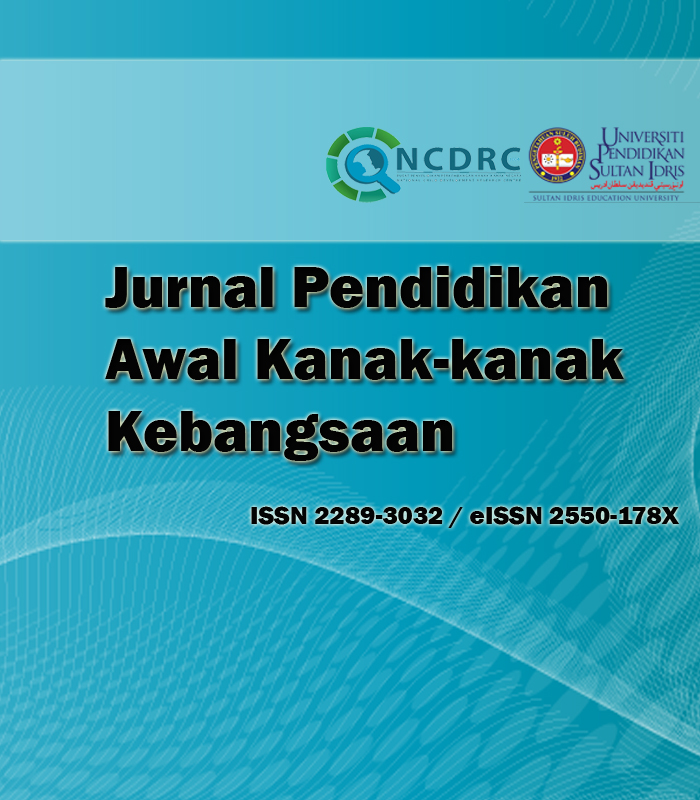The developments and challenges of the integration of interactive whiteboard technology in teaching and learning reading skills for preschool children
DOI:
https://doi.org/10.37134/jpak.vol9.2.5.2020Keywords:
interactive whiteboard technology, reading skill, preschoolAbstract
Technological advances in education have expanded to preschool, primary, secondary and tertiary education. It is fundamental for the effectiveness of teaching and learning a subject in the classroom. The writing of this article covers the development of IWB in education and the advantages of IWB that are relevant to teaching and learning and to what extent they assist the development of preschool children, the challenges for teachers and children in using interactive whiteboard and ICT in teaching and learning and understanding the readiness of teachers and preschool children in the application of ICT especially IWB in teaching and learning reading skills. The review of the literature covers the development of the use of IWB in education, the advantages of IWB that help improve the knowledge and skills, the challenges and readiness of teachers and children in the integration of IWB in learning reading skills. The use of ICT especially IWB in learning can improve children's knowledge and skills. The features of IWB create a fun learning environment especially when teachers are teaching literacy skills. The challenges faced by teachers in integrating IWB in teaching and learning are time constraints to plan lessons, lack of training, teacher attitudes and the lack of technical support. The use of technologies in teaching is an added value in improving the quality of existing teaching to make it more effective. The teachers who use IWB in the classroom depend on their pedagogical skills and how they convey the lesson using this technology. The use of IWB is one of the initiatives of the preschool teachers to increase children’s literacy skills especially reading skills.
Downloads
References
American Association of College for Teacher Education. (2010). 21st century knowledge and skills in educator preparation. American Association of colleges of Teacher Education. https://files.eric.ed.gov/fulltex/ED519336.pdf
Arshad. M. (2013). Pendidikan literasi awal kanak-kanak: Teori dan amali. Penerbit Universiti Pendidikan Sultan Idris.
Azizan, N., & Hussin, M. S. H. (2017). Penguasaan asas membaca Bahasa Melayu melalui program LINUS di utara Semenanjung Malaysia. Jurnal Pengajian Melayu, 28. Ejournal.um.my/index.php/JPM/article/view/9633.
Boubour, M., & Bjorklund, C. (2014). Preschool teacher’s reasoning about IWB embedded in Math education in Swedeen preschool. Journal of Nordic Early Childhood education Research, 7, 1-16. https://doi.org/10.7777/nDf.608.
Bourbour, M., & Masoumi, D. (2016). Practice what you preach: The Interactive whiteboards in preschool math education. Early Childhood Development Care. https://doi.org/10.1080/03004430.2016.1192617.
Bungga, F. (2018, Nov 30). Program LINUS dihentikan mulai 2019. Berita Harian Online. bharian.com.my/ berita/Pendidikan/2018/11/503726/program-Linus-dihentikan-mulai-2019.
Chear, S. S. L., & Yunus, M. M. (2019). Strategi penerapan kemahiran abad ke-21 dalam latihan guru prasekolah. Southeast Asia Early Childhood Journal, 8(1), 1-10. https://doi.org/10.37134/saecj.vol8.no1.1.2019.
Chee, S. C., Arshad, M., & Ayob, A. (2018). Penilaian semula pengajaran dan pembelajaran dalam pembacaan awal. International Journal of Education Psychology and Counseling, 3(10), 1-8. https://doi.org/10.37134/jpak.v016.sp.6.2017.
Giannikas, C. N. (2016). The use of interactive whiteboard: Enhancing the nature of teaching young language learner. In S. Papadima_Sophocleous, L. Bradley & S. Thouseny (Eds.). CALL Communities and Culture – shorts paper from EUROCALL, (pp.160-166). Book.google.com.my/books?hl=en&id=TN6_DQAAQBAJ&oi=fnd&pg=PA160&dq=the+use+of+interactive+whiteboard+enhancing+the+nature+of+teaching+young+language+learner.
Hoffman, J. L. (2010). Looking back and looking forward: Lessons learned from early reading first. Childhood Education, Fall, 8-16. https://doi.org/10.1080/00094056.2010.10521433.
Iliyas, S. S., & Jumaat, N. F. (2020). Pembelajaran menerusi aplikasi mudah alih & kesan terhadap pembelajaran huruf hijaiyah murid prasekolah. Innovative Teaching and Learning Journal, 3(2), 30-41. https://www.researchgate.net/publication/339212720_Pembelajaran_menerusi_aplikasi_mudah_alih_dan_kesannya_terhadap_pembelajaran_huruf_hijaiyah_murid_prasekolah.
Kamaruddin, K., Che Abdullah, C. A., & Idris, M.N. (2017). Intergrating ICT in teaching and learning: A preliminary study on Malaysian private preschool. International Journal of Academic Research in Business and Social Science, 7. Hrmars.com/hrmas_paper/integrating_ICT_in_teaching_and_learning_a_preliminary_study_on_Malaysian_private_preschool.pdf.
Kementerian Pendidikan Malaysia. (2017). Dokumen Standard Kurikulum Prasekolah Kebangsaan. Author.
Marxen, C., Ofstedal, K., & Danbom, K. (2008). Highly qualified kindergarten teachers: Have they been Left behind? Journal of Early Childhood Teacher Education, 29(1), 81-88. https://doi.org/10.1080/10901020701878693.
Masnan, A. H., Anthony, N. E., & Zainudin, N. A. S. (2019). Pengetahuan pengajaran dalam kalangan guru prasekolah. Jurnal Pendidikan Awal Kanak-Kanak Kebangsaan, 8, 33-41. https://ejournal.upsi.edu.my/index.php/JPAK/article/view/3156
Mohamed, N., Hassan, H., & Abu Hassan, N. Z. (2015). Tahap kesediaan pengintegrasian taknologi maklumat (ICT) dalam pengajaran terhadap murid-murid prasekolah: Satu tinjauan. https://www.ipgkik.com/v2/uploads/2015/05/Artikel18.
Mousa Malkawi, N. A. (2017). The effect of using smart board on the achievement of tenth grade students in English language and on verbal interaction during teaching public school. International Research in Education, 5(1). Researchgate.net/publication/320491050_The_Effect_of_Using_Smart_Board_On_The_Achievement_of_Tenth_Grade_Students_in_English_Language_on_Verbal_Interaction_During_Teaching_in_Public_School.
National Association for the Education of Young Children. (2008). Developmentally appropriate practice in early childhood programs serving children from birth through age 8. A positive Statement of the National Association for the Education of Young Children. Author
Peng, C. F., & Fikri Ismail, M. (2020). Perlaksanaan pendekatan bermain dalam pengajaran dan pembelajaran bahasa Melayu murid prasekolah. Jurnal Pendidikan Awal Kanak-kanak Kebangsaan, 9(1), 14-25. https://ejournal.upsi.edu.my/index.php/JAPK/article/view/3400
Puteh, S. N., & Abd Salam, K. A. (2011). Tahap penggunaan ICT dalam pengajaran & pembelajaran & kesannya terhadap hasil kerja & tingkah laku murid prasekolah. Jurnal Pendidikan Malaysia, 36(1), 25-34. ukm.my/jurfpend/jurnal%202012/JP36(1)%20Chap%203new.pdf.
Rahman, S., Nordin, A. B., & Alias, N. (2013). Penggunaan ICT merentasi Kurikulum Standard Prasekolah Kebangsaan (KSPK): Tinjaun di prasekolah Kementerian Pelajaran Malaysia. JUKU: Jurnal Kurikulum & Pengajaran Asia Pasifik, 1(4). jice.um.edu.my/index.php/JUKU/article/view/7964.
Resnick, M. (2007). All I really need to know (about creative thinking) I learned (by study how children learn) in kindergarten. In creativity & Cognition Conference. https://doi.org/10.1145/1254960.1254961
Scott, C. L. (2015). The futures of learning 3: What kind of pedagogies for the 21st century? UNESCO Education Research and Foresight, Paris.
Siraj-Blatchford, I. (2009). Conceptualising progression in the pedagogy of play and sustained shared thinking in early childhood education: A Vygotskian perspective. Educational and child psychology, 26, 77-89. https://www.researchgate.net/publication/320194826_Conceptualising_progression_in_the_pedagogy_of_play_and_sustained_shared_thinking_in_early_childhood_education_A_Vygotskian_perspective
Tasripin, N., & Abu Bakar, K. (2018). Permainan interaktif dalam pembelajaran pranombor dan Pendidikan Matematik prasekolah. Dalam Seminar Antarabangsa Isu-Isu Pendidikan, UM.
Wrahatnolo, T., & Munolo. (2018). 21st centuries skill implication on Educational System. IOP Conference Series: Materials Science and Engineering, 296.
Yi-Fang, L., & Shu, C. Y. (2016). The effect of the interactive functions of Whiteboard on elementary students learning. Journal of Education Computing Research. https://journals.sagepub.com/doi/abs/10.1177/0735633115628032.





